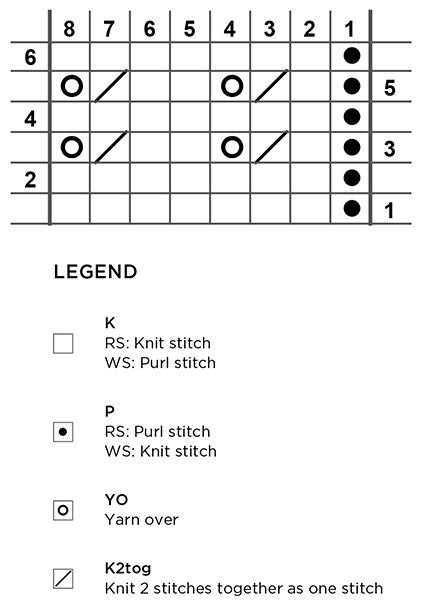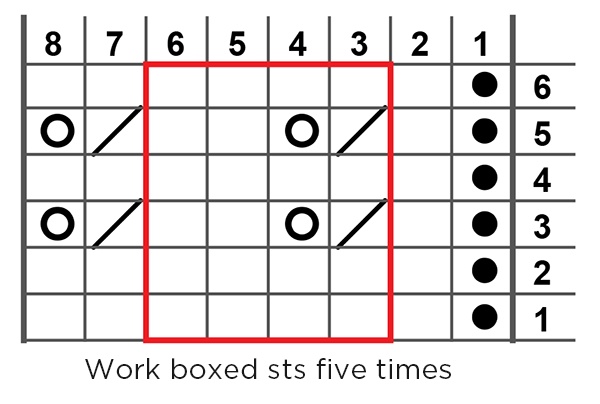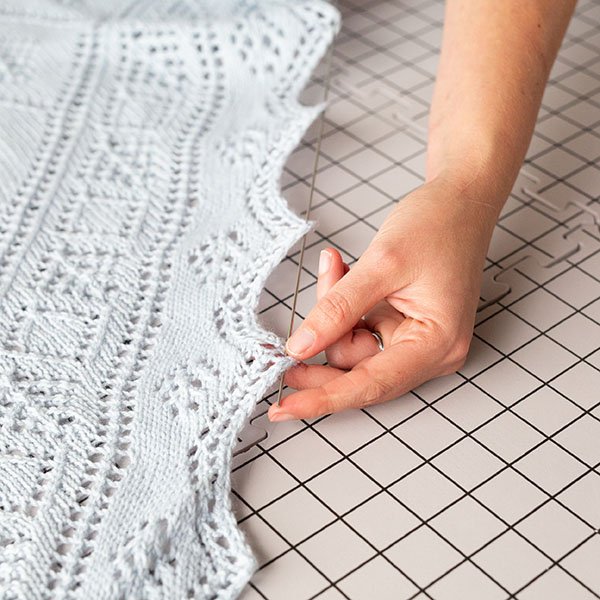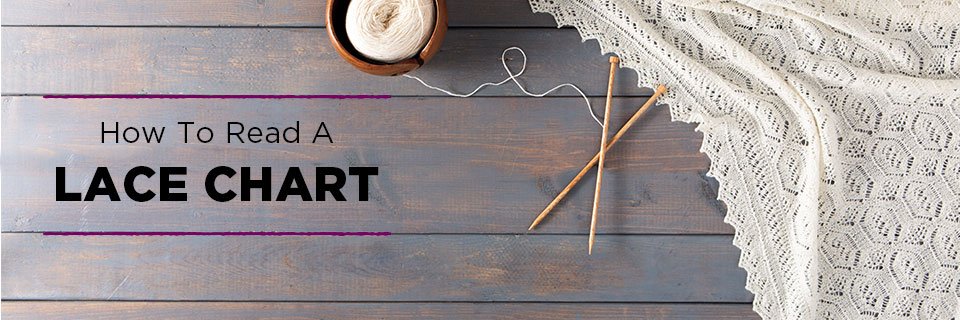Charts are a wonderful visual aid for those who get lost using textual instructions. They allow you to see intricate stitch patterns in a new way and make it easier to document your progress as you work along. The majority of lace knitting projects will involve a chart or two, regardless of their skill level. Many lace patterns are comprised solely of charted instructions. Either way, chart reading is a valuable skill for any knitter to possess.
Intro to Lace Charts
Want to try out knitting lace from charts for the first time? Don’t stress; no need to be intimidated! To start you on your lace knitting journey, first check out this video which will introduce you to the concept of lace charts:
Chart reading in the round
If knitting a piece of lace in the round, you will read the chart from right to left on every round. For instance, on this chart, you will notice that all of the rounds are marked with numbers on the right hand side. This is an indication that you will begin each round on that side, the right side. The first and second rounds have you knit every stitch. In Round 3, you would knit 2 stitches, knit 2 stitches together, yarn over, knit 2 stitches, knit 2 together, and yarn over to complete the repeat. Next you would begin at the right side of Round 4 and so on.
Note: It is very important to read through the legend for your chart before you begin. Stitch symbols are not universal! What is a knit on one chart could be a purl on another.

Chart reading with flat knitting
When knitting a project flat, you knit back and forth, turning your work each time you finish a row. The row numbers now alternate between the left and right hand sides of the chart. This indicates that you would begin with Row 1, a right side row, reading it from right to left. When you finish Row 1 and turn your work to begin Row 2, you'll begin from the left side of the chart where the number “2” is. Working from the opposite side of the chart compensates for the fact that you are now working across the “wrong” side of your knitting. You may also find that the symbols for the stitches are worked differently at this point. Since you will be working on both sides of the knitting, a symbol on the chart may have a different meaning depending on which row you are working. For example, the dot will be purled on the odd rows (the right side) and knit on the even rows (the wrong side).

Potentially puzzling aspects of lace charts
There are a few symbols you may encounter that could be confusing. Most lace patterns involve various decreases to eliminate stitches and yarn overs to restore stitches. There may be rows, however, where you have fewer stitches than in previous or future rows. When this happens, you will see some boxes on the chart that are blacked or grayed out — you needn’t do anything in your knitting when you see one. In the example row shown, you would simply knit 6 stitches. In a later row, these blanks may be replaced by yarn overs restoring the stitch count to 8.

Another peculiarity you may find when knitting lace charts is an indication for repeating a certain section of stitches. Often, your chosen project will feature a repeat section that is duplicated a specific number of times to create a desired width or length. Instead of providing a chart that is unreasonably wide, the pattern will include instructions for repeating certain sections.
As you are working the repeat sections, you may choose to place a stitch marker each time you begin the repeated stitches. In complex lace knitting, this is an essential step in keeping your knitting organized. It will allow you to count your stitches effortlessly by presenting them in smaller groups and will help you to quickly identify mistakes. Repeated sections are most often bounded by red boxes (as shown) or dark vertical lines to help emphasize and define the group of stitches that will be repeated.
In this example, the 4 center stitches will be repeated five times total. You will work stitches 3-6 five full times before moving on to finish stitches 7-8. Completing any row of this chart will leave you with a total stitch count of 26.

Tips for reading lace charts

Many charts can be difficult to see and read because of their size or abundance of graphic symbols. For that reason, we offer the following tips to keep you reading charts for ages!
Try enlarging the chart on a photocopier, or scanning it and printing it out at a larger size.
Use a highlighter to mark every other row. This will make the rows stand out better and will make it easier on your eyes to return to your chart after a break. This also helps identify right side versus wrong side rows.
A Chart Keeper is an invaluable, portable tool to help you stay on track with your lace chart wherever your knitting takes you. With various magnets and a magnetic backboard, it holds your pattern in place and allows you to block off the rows of the chart that you have already completed.







